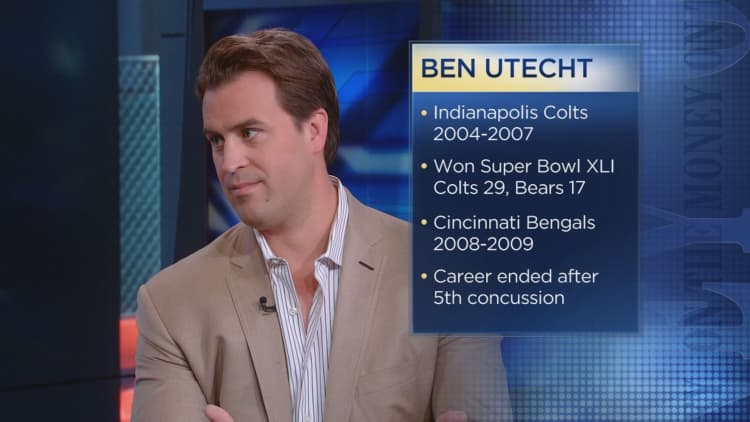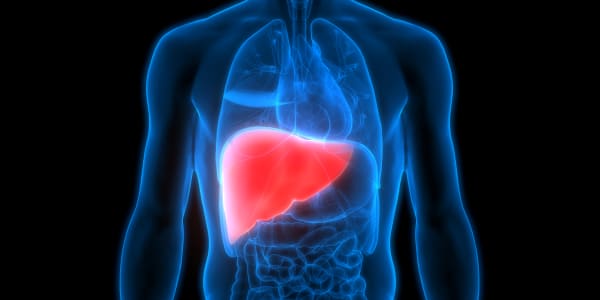Sunday's Super Bowl will mark the end of a grueling season for approximately 1,700 professional football players. For hundreds of them, the off season will offer a respite from the risk of brain-addling injuries that are all too frequent during games and practices. At least, until training starts up again.
Concussions are a big deal in football at the moment — arguably an even bigger deal than the fact that this is Tom Brady's seventh Super Bowl. Researchers have made a lot of progress on diagnosing, treating and preventing concussions, but they still have questions about how concussions happen. What they discover might change the game for good.
Over the past few years, scientists have learned a lot about concussions. But before that, progress was slow. There wasn't enough funding to do the kind of research that was needed, and the NFL likely suppressed concussion research, according to investigations after the fact.
The suicide of several former players and even a movie starring Will Smith has brought an influx of funding to the field, and researchers have collected a lot of data about concussions. Experts still feel they have more questions than answers about concussions, but as they process the data they collected, that may change.

"This is an ever burgeoning area of study. You're looking at a lot of different entities that got into concussion [research]," said Richard Figler, an orthopedic surgeon and co-medical director of the Concussion Center at the Cleveland Clinic. Though doctors are very good at managing concussions, he adds, they have a lot more to learn to better diagnose and understand them.
In 2015 there were 271 concussions diagnosed in the NFL, the highest number on record. But concussions happen in other sports, too, especially contact sports such as soccer, hockey and boxing. Studies show that people who get one concussion are several times more likely to get another.
If the head or body are hit with a sudden jolt, the brain can hit the inside of the skull, creating damaging chemical changes we know as a concussion. Imaging tools such as MRI and CT scans usually don't show the kinds of damage doctors are looking for, so they diagnose concussions based on the symptoms the patient demonstrates.
"If someone gets hit in the head or body and they have a constellation of symptoms suggestive of a concussion, by history we have defined it as a concussion," said Figler. They look at factors like slowed reflexes, pain in the head or neck, bad balance or memory loss.
The problem is that concussions vary substantially depending on which part of the brain is affected, the severity of the damage and simply the individual. "There's an old adage among people like me who see hundreds of concussions a year: If you've seen one concussion, you've seen one concussion," Figler said. The symptoms of multiple concussions can even vary in the same patient.
The long-term effects of concussions can range from negligible to life-altering. A growing body of evidence suggests that repeated head injuries, both those that cause concussions as well as smaller hits that cause no symptoms, can over time cause Chronic Traumatic Encephalopathy (CTE), a degeneration of brain tissue that can result in depression, impulse control problems, motor control issues like tremors, and dementia.
And it's not just pro football players who are at risk — a 2013 study estimated that high school football players received 11.2 concussions per 10,000 "athletic exposures" (games, practices); for college football players it was 6.3.
Genetics at work
Researchers are starting to understand what makes certain people more or less likely to develop concussions. Some suspect that there might be a genetic component. Others are studying how concussions might occur in and affect women and children, which haven't gotten as much research attention in the past.
Factors like these, and others such as stress or returning too soon to normal activities, can affect how long it can take an athlete to recover from a concussion. Most athletes who get concussions see their symptoms go away within two weeks, and they can gradually ease back into physical and mental activity as they recover. But a lack of symptoms doesn't always mean the brain is fully healed, Figler said. And returning too quickly to regular day-to-day life might even cause lasting damage.
Researchers and doctors still aren't sure when exactly a concussion ends. "The biggest question people still have is when does the injury really stop occurring and is it ever really completely recovered," said Wayne Sebastianelli, the medical director of athletic medicine at Penn State.
More from Modern Medicine:
Hyundai debuts a miracle device that can help paraplegics walk
Finally, new hope to eradicate pediatric brain cancer
Parkinson's linked to bacteria in the gut
To assess concussions more reliably, researchers are looking for indicators called biomarkers that can indicate if a patient has a concussion. Ideally, the biomarker would be a type of protein or by-product of the injury that doctors would be able to detect in a simple test of a patient's blood or saliva.
"The ideal test for a concussion is something very easily reproducible, inexpensive and something with specificity to make sure we're not missing any [cases] but also so that we aren't overdiagnosing them," Figler said. There have been a few promising candidates, but so far the tests aren't reliable enough to be used in clinics. Other tests on the eyes or balance are more developed but still aren't foolproof, Figler added.
Some researchers are looking into more sophisticated treatments. Today rest and gradual return to normal activities are the only way to treat a concussion. But scientists are starting to look into interventions that might be able to reduce the injury and speed up the recovery process. When injuries happen in the brain, like anywhere else in the body, the immune system responds with inflammation, a cascade of biological responses that send blood, white blood cells and lots of other chemicals to the damaged site.
I don't think there will ever be a concussion-proof helmet.Wayne Sebastianellimedical director of athletic medicine at Penn State
Sometimes, though, the immune response can cause more damage than the injury itself, which can make it slow to heal. Researchers are looking at different compounds that might stop the inflammation process before it becomes harmful. One such intervention, an antiviral agent called amantadine, has showed some interesting initial results.
Researchers are also devoting more attention to the long-term effects, such as CTE. The condition has only been discovered after patients died and scientists examined their brains. Researchers spent years convincing people that CTE is a real condition, said Ann McKee, a professor of neurology and pathology at the CTE Center at Boston University.
Now that there's greater awareness and funding, McKee and her colleagues are working on a way to diagnose the condition in living people. That understanding will help them develop treatments or interventions for CTE. "We know a lot of people are concerned that they have this — they've mentioned trouble with memory, organization and planning. We want to bring them some hope, something that will make their lives better," McKee said.
Though some engineers have been thinking creatively about helmets and protective gear that can prevent concussions, experts agree that gear is unlikely to be the silver bullet to stop injuries from happening. "I don't think there will ever be a concussion-proof helmet," said Penn State's Sebastianelli, because the brain can still be injured if it hits too hard into the skull.
Instead, in order to protect athletes from debilitating injuries, sports officials are starting to make changes in the culture and rules of the games themselves. Last year the NFL updated the rules regarding kickoffs so that fewer players would be injured in the brutal collisions that happened often upon return. The rules of youth football just got an overhaul to make the sport safer for young athletes. More profound changes for football may be on their way; other contact sports, such as soccer and hockey, are slowly following suit.
But the experts don't want to see football go extinct. Both Sebastianelli and Figler plan to watch the big game on Sunday. "I just want to see people play well and not get hurt. I don't care who wins," Sebastianelli says.
— By Alexandra Ossola, special to CNBC.com




